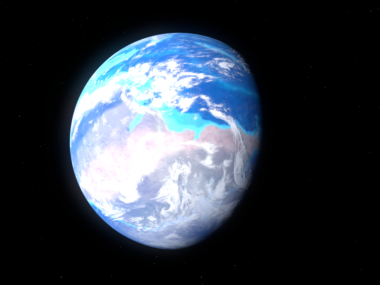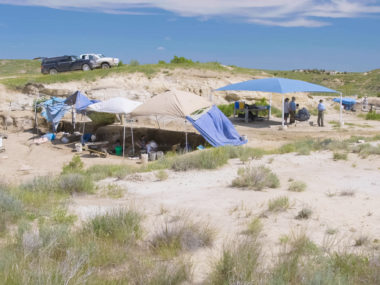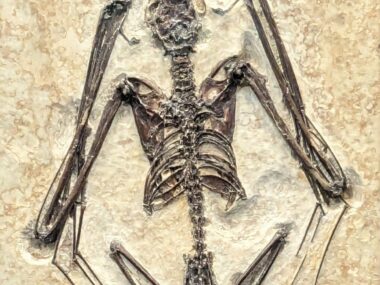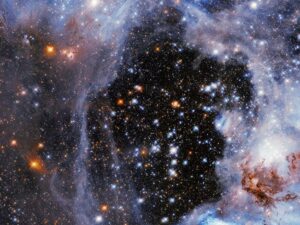For many, the history of young-earth creationism (YEC) starts with the 1961 publication of The Genesis Flood: The Biblical Record and its Scientific Implications by John Whitcomb and Henry Morris. We cannot overstate the impact of this incredible work. This game-changer caused Christian leaders and teachers to reevaluate their views on the scientific plausibility of the Creation and Flood account of Genesis. But The Genesis Flood is not the beginning of the modern YEC movement. To discover that, we’d have to dig into the history of an individual by the name of George McCready Price.
The following is a summary of “Contributions to creationism by George McCready Price“ by Kurt Wise, and of the surrounding discussion and research pertaining to it. The views expressed are not necessarily those of the New Creation.
The Life and Times of George McCready Price
George McCready Price was born on August 26, 1870 in Havelock, New Brunswick, Canada. Price is presumed to have become a believer around the age of 14 when he joined the Seventh-Day Adventist church. He believed that God wanted him to blot out the conventional view of earth history. Others who came after him could then further develop a biblically-consistent understanding of it.
Over the course of sixty years or so, he published around 30 books, at least a dozen tracts, and more than 800 articles in support of YEC. He served as editor of two short-lived young-earth creationist journals in 1905 and 1906. Sadly, no known copies of either exist today. He also founded the very first (and short-lived) young-earth creationist society —with its own journal. He even directly trained, and/or heavily influenced several well-known creationists of the middle 20th century. This includes Harold Clark, Frank Marsh (founder of what we now call baraminology), and Clifford Burdick.
Echoes from the Past
Much of his work still echoes throughout creationist circles to this day. Henry Morris even stated that the early manuscripts of The Genesis Flood’s portions on geology were “…essentially merely a survey of George McCready Price’s arguments.” In the early 20th century, Price was by far the most well-known young-earth creationist in the world.
It would be a mistake to credit Price as the first advocate for young-earth creationism. This was, in fact, the historical position among most Jews and early Christians up until the rise of uniformitarian geology. In response came the “young-earth creationists” of the early 19th century known as scriptural geologists. While the creationists of yesteryear don’t seem to have influenced Price much, he was like them in many ways. Just like the scriptural geologists of old, he was adamant in his quest to disprove the old-age paradigm. Unfortunately, he never fully developed a model to replace it.
Nevertheless, paleontologist Kurt Wise has collected the various aspects of the Creation/Flood model Price “established” over the course of his ministry. We will summarize this in the following article. Please see Dr. Wise’s paper cited below for further details.1
Similarities to Modern Creationism

Much of what Price argued for would not be out of place among creationists today. He believed the Bible to be a source of absolute truth, authoritative over the conclusions of science. God provided the Bible to mankind so we could learn about things (be it history or otherwise) that we would not discover on our own. He argued that the historicity of Genesis served as the foundation for the Bible—and Christianity. Naturally, this led to his rejection of alternative interpretations of the Creation narrative. Specifically, this refers to Gap Theory, Theistic Evolution, Progressive Creationism, pre-Adamite Theory, and Day-Age Theory.
Price also believed that God would reveal a scientific (deductive) case for scriptural truth built on demonstrable facts of nature. This would leave people in the end times ‘without excuse.’ He argued that the difference between creationists and evolutionists has nothing to do with the data itself. It has to do with the interpretations of that data. (Dr. Wise takes issue with this. He argues that since “Scripture functions as both a potential falsifiability criterion for scientific theories and a starting point for science, then Scripture is—or ought to be—data. This means that creationists and non-creationists do not use the same data. Creationists use—or ought to use—more data than the non-creationist”).
Natural Species
Price stated innumerable times he believed God created life ‘some six or seven thousand years ago’ in six, 24-hour days. He refers to the units of life God created as ‘natural species.’ We should not confuse this term with our common usage of the word “species.” Price defines a natural species as a group of similar organisms surrounded by distinct differences from other organisms. Some examples he cited include members of the genus Bos (cattle), pigs, canids (dogs), ursids (bears), felids (cats), elephantids (living elephants and mammoths), Drosophila similans and Drosophila melanogaster (fruit flies), and equids (horses). ‘Natural species’ are essentially what modern creationists refer to as ‘created kinds’. These are roughly equivalent to the family or genus level in modern taxonomy. According to Price, the members of a ‘natural species’ could be identified. They would possess overall similarity and be organisms capable of interbreeding.
Price argued that evolution between different ‘natural species’ was impossible. He insisted such drastic change was not alluded to by the fossil record. He rebutted claims that embryological recapitulation was valid evidence for Darwinian evolution. Since all organisms began as a single cell in the mother’s womb, he argued, well-designed organismal development will pass through broadly similar stages so as to develop into an adult form. However, Price also believed ‘natural species’ were capable of great biodiversity via natural selection, adaptation, enhancement, or other means. These mechanisms would not be Darwinian in nature, but rather were degenerative, natural processes.
The Fall
Price believed in a literal Fall of man and that the pre-Fall world was characterized by idyllic living conditions. “Before the entrance of evil, peace and happiness prevailed throughout the universe. Not only did inanimate nature act in perfect harmony with the divine will, but all created beings were also in perfect harmony with their Creator. Love for the divine Father was supreme, love for one another unselfish and impartial.” There was no carnivory. Price also taught that the rivers of Eden were destroyed by the Flood. When the first humans sinned, Price argues that God cursed the creation in response. This introduced suffering and death into the world, just as young-earth creationists accept today.
Fossils from the Flood
Like many creationists today, Price argued that most of the geologic record (as well as the fossils it contains) were the result of the global Flood. This was a rather innovative development. Most of the scriptural geologists before him merely argued that the Flood left behind major geologic evidence in its wake. He cited several evidence in support of rapid burial and sedimentation during the Flood. Fossil evidence cited by him includes mollusks with closed shells (indicating they were still alive upon burial). Price also cites geologic evidence in the virtually flat, featureless contact surfaces between successive rock layers. This indicates little to no time occurred between them. He inferred from the “fountains of the great deep” mentioned in Genesis 7:11 that the disruption of the ocean was the chief cause of the Flood.
Price thinks that moving water laid down the fossil-bearing rock strata (especially since, according to him, only moving water can deposit sandstones). Tidal oscillations were responsible for producing alternate terrestrial and marine layers during the Flood, such as that seen in the Carboniferous cyclothems. According to Price, lithification (the conversion of loose sediment grains into rock) was much like the setting of concrete. Much of the sediment in Flood deposits existed in the pre-Flood world in an unlithified state.
The Geologic Column
Price is well-known for his staunch disagreement with the concept of the worldwide geologic column. What many do not know is that he did accept local geologic columns. Much like modern creationists, he attributed the order of fossils within these layers to the order in which pre-Flood ecological zones were submerged and sorted by water. Price explained the origin of modern mountain ranges as occurring near the end of the Flood, or perhaps even after. He reasoned that the processes behind their creation were unlike any researchers observed in the present.
Human Fossils
One of the most prominent mysteries for Price is the same as for creationists now. This is the seeming absence of human fossils in Flood sediments. As late as 1913, Price firmly believed that researchers had found human fossils and artifacts in Flood layers. A shift in his position on this topic occurred, however. By 1931 he began offering explanations as to why humans were not being found. Perhaps humans did not live in the same places as the animals that became fossilized, or maybe they lived in an area not yet searched by fossil hunters. Maybe God specifically destroyed pre-Flood humans, or they were buried in the topmost Flood layers, only to be eroded out and decomposed in early post-Flood times. Another possibility Price suggested was that evolutionists suppressed human fossil finds.
Regional Ice Age
Price believed that a brief regional (non-global) ice age occurred after the Flood. Interestingly, his explanation for this event is quite similar to that proposed by Dr. Michael Oard.2 He proposed that evaporation from warm pre-Flood ocean water left behind in large lakes combined with cooling continents. The effect caused high rain or snowfall, depending on altitude and latitude. Snow accumulated in mountain regions until they formed huge glaciers.
Human Descendants
Finally, let us review the similarities between Price’s position on the dispersion of humans after the Flood and those adhered to by modern-day creationists. Though assigning most fossils to the Flood, he attributed the human (and ape) fossil record to post-Flood times. He considered Cro-Magnon, neanderthals, Piltdown Man, and Homo erectus to be degenerate descendants of Noah, but Cro-Magnon to be physically superior to modern humans.
Dissimilarities to Modern Creationism
Although creationists today accept much of what Price believed, it is also worth discussing what has fallen out of favor as science and our study of Scripture marches on.
The Universe
Price believed that God made our Solar System during Creation Week. However, he believed that what exists outside of our Solar System He created at some point beforehand. This is not to be confused with Gap Theory, which advocates our Solar System and everything in it was created in between Genesis 1:1 and Genesis 1:2. Most creationists today reject this notion because Exodus 20:11 states that God created the heavens, earth, sea and everything in them within the span of six days.
Pre-Flood Climate

According to Price, fossils of coral and coal in arctic regions indicated that a favorable subtropical climate covered the entire pre-Flood world. It is important to note that he formulated these ideas before researchers discovered they could use paleomagnetism to determine the motion of continents in the past. In addition, plate tectonics had not yet been widely accepted by the time of his death. While many non-scientist creationists still believe this, creation scientists who specialize in paleontology or geology advocate that variation would have existed in pre-Flood climates. That being said, perhaps the tropical and subtropical zones were wider than at present and the temperate zone may have reached all the way to the poles.3
Apes
There is not much difference in what Price believed about created kinds (‘natural species’) that creationists don’t also accept today. However, he explained the existence of modern cold-adapted organisms as having lived at the highest (and therefore coolest) altitudes of pre-Flood hills and mountains. He also believed that pre-Flood humans were of giant stature (much like many of the dinosaurs and other animals). Interestingly, while he did not believe apes were ancestral to humans, Price did believe that apes were degenerate descendants of Noah. This is something no creationist today accepts.
Fossils and Floodwaters
George McCready Price was one of the first creationists to popularize the notion that all but the topmost organisms in the fossil record were buried in the Flood. The localized and regional extent of Cenozoic deposits puzzled him when compared to the widespread nature of Paleozoic and Mesozoic sediment layers. Modern creationist geologists actually use this as evidence the Cenozoic is from post-Flood times.4 Price attempted to answer this puzzle by suggesting that large, freshwater lakes dotted the pre-Flood landscape. Intriguingly, Price does not seem to have accepted the possibility of global or transcontinental Flood deposits, despite accepting a global Flood, and instead argued that the Flood sedimentation was local. “…geological formations merely represent ancient floras and faunas buried near to their former habitats…”
Price correctly asserted that there is more than enough water on the earth right now to flood the planet’s surface. However, he argued that an astrononmical disturbance is responsible, causing the earth’s axis to wobble so that the ocean water sloshed onto the land. Today, many creationist geologists explain the flooding of the pre-Flood world by rapid plate tectonics during the Flood as proposed by geophysicist John Baumgardner and others called Catastrophic Plate Tectonics.5
Mammoth Preservation
Despite believing in a post-Flood ice age, Price argues that woolly mammoths and other mammals somehow died during the Flood by a sudden freeze, preserved standing upright and with “tropical” vegetation still in their mouths and stomachs. Since they are buried in surface sediments, he says, their bodies must have floated through the duration of the Flood. Considering that he also brings up the point that some mammoths were buried upright, it is puzzling why he thought this. On the other hand, most creationist paleontologists of today place woolly mammoths in the Ice Age.6
The Geologic Column
Last but not least, we cannot neglect the dissimilarity from modern creationism that so well distinguishes George McCready Price: he did not accept a worldwide geologic column. He felt that each local geologic column contained only the diversity found in that specific region of the earth, something even those he influenced (most famously, Harold Clark) disagreed with!7
The Measure of a Man
While there is a great deal of what George McCready Price taught that modern YEC’s would not agree with, the echoes of his early Creation/Flood model still resound among us today. Quite striking, then, how few creationists are aware of the many contributions Price made. Many do not even who he was. This is made even more surprising considering how well-known Price was in his day.
Dr. Wise tentatively links this to a decision made by Whitcomb and Morris.8 They did not reference Price’s intellectual contributions in The Genesis Flood, published two years before Price’s death. Dr. Wise further suggests that this may have initiated an unfortunate habit among some creationists of not citing original sources, making the development of YEC over the years difficult to track.9 We also lack understanding of where Price got the ideas for his model. Sometimes he referenced scientists like William Dawson, popular writers like Henry Howard, and fellow Seventh Day Adventist writers like Ellen G. White, but other times who his sources were are unclear. This makes it impossible for us to determine which ideas were original to Price.
Dr. Wise suggests that the creationist community begin reconstructing the intellectual history of creationism. This effort would involve figuring out which of Price’s ideas were his own or inspired by others, and who popularized his original ideas by passing them down to others, thus discovering Price’s true intellectual contribution.10
The Way Forward
Dr. Wise puts forward the following questions that this endeavour must answer:11
- “How many of what this article identifies as ‘echoes’ of Price actually did come through the work of Price?”
- “How much of Price’s work—both that portion borrowed from others and that portion birthed in Price’s mind—was passed on to others?”
- “Who passed it on, and what was their contribution?”
- “How much of what we believe or debate about today is based on Price?”
- “How much of what we believe today is no longer justified, but believed only because it was passed on?”
- “How much of the discussion has been lost along the way that might actually be valuable to us in our discussion today?”
The only way we can know how far we as young-earth creationists have come is to comprehend how far we’ve been.
Footnotes
- Wise, K.P. 2018. “Contributions to creationism by George McCready Price.” In Proceedings of the Eighth International Conference on Creationism, ed. J.H. Whitmore, pp. 683–694. Pittsburgh, Pennsylvania: Creation Science Fellowship. ↩︎
- Oard, Michael J. (1986) “An Ice Age Within the Biblical Time Frame,” Proceedings of the International Conference on Creationism: Vol. 1 , Article 48. Available at: https://digitalcommons.cedarville.edu/icc_proceedings/vol1/iss1/48 ↩︎
- Wise, K. 1992. “Were There Really No Seasons? Tree Rings and Climate,” Creation Ex Nihilo Technical Journal 6 (2): 168–172. ↩︎
- Whitmore, John H. and Garner, Paul (2008) “Using Suites of Criteria to Recognize Pre-Flood, Flood, and Post-Flood Strata in the Rock Record with Application to Wyoming (USA),” Proceedings of the International Conference on Creationism: Vol. 6, Article 35. ↩︎
- Austin, Steven A.; Baumgardner, John R.; Humphreys, D. Russell; Snelling, Andrew A.; Vardiman, Larry; and Wise, Kurt P. (1994) “Catastrophic Plate Tectonics: A Global Flood Model of Earth History,” Proceedings of the International Conference on Creationism: Vol. 3 , Article 56. ↩︎
- Ross, M. 2013. Why Were the Animals So Big? Answers in Genesis. https://answersingenesis.org/extinct-animals/ice-age/why-were-the-animals-so-big/ ↩︎
- Clark, H.W., Fossils, Flood, and Fire. Outdoor Pictures, California, 1968. ↩︎
- Wise, K.P. 2018, pp. 683–694. (Footnote 1) ↩︎
- Wise, K.P. 2018, pp. 683–694. (Footnote 1) ↩︎
- Wise, K.P. 2018, pp. 683–694. (Footnote 1) ↩︎
- Wise, K.P. 2018, pp. 683–694. (Footnote 1) ↩︎












Love this history of Price, this is like a beginning of a scholarly research on Plato or George III but in creationist thought instead. Nice article, Christian!
Price was an incredible researcher and poured through thousands of pages of scholarly material while putting together his views. And he was like his peers in not profusely footnoting all things. (That became popular while he was alive, but well after he had formed his habits.) I appreciate Wise’s efforts to systemize our history. And I appreciate that if Price were yet living he would have been early to update his views as research progressed. Regarding paleoclimates, I too suppose that cold came as a result of the curse, cold-weather fauna not being found anywhere in the Cenozoic or lower.
Although Price advocated his young solar system, old universe view throughout much of his life, it should be noted that in his later years, price embraced a young biosphere view, with an old universe and old planet earth, but young life and life supporting phenomena on earth. In other words, he believed that our planet was old, but that our ordered world with its living organisms was young.
Can you provide a reference for where you found Price “embraced a young biosphere”?
I haven’t got word from Bob Helm where he got the idea that George McCready Price adopted an “old planet earth” view with merely “a young biosphere.” My guess is he derived it from an article entitled “In the Beginning” that Price wrote in this journal: The Forum: For the Correlation of Science and the Bible : Vol. I and II, 1946-1948. (1948). United States: Society for the Study of Natural Science.
If so, then it seems blatantly wrong to interpret from this article that Price abandoned his young earth view especially in light of the last two paragraphs of the article which begin as follows:
URL: https://www.google.com/books/edition/Early_Creationist_Journals/tyBWBBQJdKYC?hl=en&gbpv=1&printsec=frontcover&bsq=%22let%20us%20assert%20again%22
While a seminary student at Andrews University, I read in the library there that George McCready Price eventually adopted the view that the core of the earth existed before creation week. Remember that Price was a Seventh-day Adventist, and YBC is a common view among SDAs and is favored by the denomination’s Geoscience Research Institute.